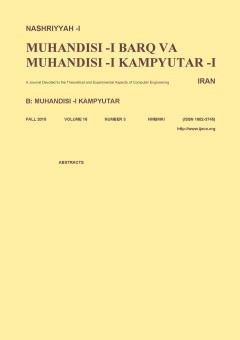ارائه يك تكنيك بهبوديافته مشبك پوشش چندتايي با استفاده از مدل حسگري احتمالي براي شبكههاي حسگر بيسيم
الموضوعات : electrical and computer engineeringعبدالرضا واقفی 1 , مهدی ملامطلبی 2
1 - دانشگاه آزاد اسلامی قزوین
2 - دانشگاه آزاد اسلامی بوئین زهرا
الکلمات المفتاحية: شبکه حسگر بیسیمپوشش منطقهرویکرد مشبکارزیابی پوشش تاییمدل حسگری احتمالی,
ملخص المقالة :
یکی از چالشهای اساسی در شبکههای حسگر بیسیم، مسأله پوشش ناحیه تحت بررسی توسط یک یا چند گره است. به علت عمر محدود حسگرها و نیاز به دادههای معتبر، کاربردهای نظارتی حساس نظیر شناسایی حریق، تشعشعات، نشت گاز، شناسایی نفوذ و غیره، پوشش منطقه تحت بررسی به وسیله چند گره حسگر انجام میگیرد که به آن پوشش تایی میگویند. اکثر تحقیقات گذشته در زمینه ارزیابی پوشش تایی بر اساس مدل حسگری باینری صورت گرفته است. تحقیق حاضر بر آن است که ارزیابی پوشش تایی را با رویکرد تقسیمبندی مشبک و از طریق مدل حسگری احتمالی و با هدف بهبود دقت و کاهش زمان ارزیابی پوشش انجام دهد. در پایان نیز روش پیشنهادی در محیط نرمافزار 2NS پیادهسازی و با روشهای پیرامونی احتمالی و مشبک باینری، مقایسه شد. نتایج حاکی از بهبود دقت به میزان 14% و 24% نسبت به روشهای مقایسهشده و کاهش زمان محاسبه ارزیابی پوشش تایی به میزان 7% نسبت به روش پیرامونی احتمالی است.
[1] M. T. Thai, F. Wang, D. Hongwei Du, and X. Jia, "Coverage problems in wireless sensor networks: designs and analysis," International J. of Sensor Networks, vol. 3, no. 3, pp. 191-200, May 2008.
[2] S. Kumar and D. Lobiyal, "Sensing coverage prediction for wireless sensor networks in shadowed and multipath environment," The Scientific World J., vol. vol. 2013, Article No. 565419, 11 pages, Oct. 2013.
[3] A. Hossain, S. Chakrabarti, and P. Biswas, "Impact of sensing model on wireless sensor network coverage," IET Wireless Sensor Systems, vol. 2, no. 3, pp. 272-281, Sept. 2012.
[4] J. Yua, X. Denga, D. Yuc, G. Wangd, and X. Gua, "CWSC: connected k-coverage working sets construction algorithm in wireless sensor networks," J. of Electronics and Communications, vol. 67, no. 11, pp. 937-946, Nov. 2013.
[5] C. Huang and Y. Tseng, "The coverage problem in a wireless sensor network," J. Mobile Networks and Applications, vol. 10, no. 4, pp. 519-528, Aug. 2005.
[6] G. Xing, X. Wang, Y. Zhang, C. Lu, R. Pless, and C. Gill, "Integrated coverage and connectivity configuration for energy conservation in sensor networks," J. ACM Trans. on Sensor Networks (TOSN), vol. 1, no. 1, pp. 36-72, Aug. 2005.
[7] C. Huang, Y. Tseng, and L. Lo, "The coverage problem in three-dimensional wireless sensor networks," J. of Interconnection Networks, vol. 08, no. 03, pp. 209-227, Sept. 2007.
[8] X. Zhang and C. Wang, "Distributed k-coverage verification algorithm based on localized distance information in WSNs," in Proc. of the IEEE Int. Conf. on Networking, Architecture, and Storage, pp. 196-199, Hunan, China, 9-11 Jul. 2009.
[9] Y. Bejerano, "Coverage verification without location information," J. IEEE Trans. on Mobile Computing Archive, vol. 11, no. 4, pp. 631-643, May 2012.
[10] H. L. Wang and W. H. Chung, "The generalized k-coverage under probabilistic sensing model in sensor networks," in Proc.IEEE Wireless Communications and Networking Conf., WCNC'12, pp. 1737-1742, Shanghai, China, 1-4 Apr. 2012.
[11] X. Shen, J. Chen, and Y. Sun, "Grid scan: a simple and effective approach for coverage issue in wireless sensor networks," in Proc. of the IEEE Int. Conf. on Communications, ICC'06, vol. 8, pp. 3480-3484, Istanbul, Turkey, 11-15 Jun. 2006.
[12] J. Sheu, G. Chang, S. Wu, and Y. Chen, "Adaptive k-coverage contour evaluation and deployment in wireless sensor networks," J. ACM Trans. on Sensor Networks, vol. 9, no. 4, Article No. 40, 31 pp., Jul. 2013.
[13] K. Juang, E. Wang, C. Chiang, and A. Chen, "Verification of k-coverage on query line segments," in Proc. of the 17th Int.Database Engineering & Applications Symp., pp. 114-121, Barcelona, Spain, 9-13 Oct. 2013.
[14] A. So and Y. Ye, "On solving coverage problems in a wireless sensor network using voronoi diagrams," in Proc. of Workshop on Internet and Network Economics, WINE'05, pp. 584-593, Hong Kong, China, 15-17 Dec. 2005.
[15] Y. Zou and K. Chakrabarty, "Uncertainty-aware and coverage-oriented deployment for sensor networks," J. Parallel and Distributed Computing, vol. 64, no. 7, pp. 788-798, Jul. 2004.
[16] S. Patnaik, X. Li, and Y. Yang, Recent Development in Wireless Sensor and Ad-hoc Networks, Springer, 2015.
[17] M. Boudali, M. Senouci, M. Aissani, and W. Hidouci, "Activities scheduling algorithms based on probabilistic coverage models for wireless sensor networks," Annals of Telecommunications, vol. 72, no. 3, pp. 221-232, Apr. 2017.
[18] M. Fernandez and S. Williams, "Closed-form expression for the Poisson-binomial probability density function," IEEE Trans. on Aerospace and Electronic Systems, vol. 46, no. 2, pp. 803-817, Apr. 2010.
[19] Y. Hong, "On computing the distribution function for the Poisson binomial distribution," Computational Statistics & Data Analysis, vol. 59, no. 1, pp. 41-51, Mar. 2013.
[20] W. Hoeffding, "On the distribution of the number of successes in independent trials," the Annals of Mathematical Statistics, vol. 27, no. 3, pp. 713-721, Sept. 1956.
[21] W. Wang, On the Number of Successes in Independent Trials, Statistica Sinica, pp. 295-312, 1993.
[22] R. Hamming, The Art of Probability: for Scientists and Engineers, Addison-Wesley Longman Publishing Co., Inc. Boston, MA, USA, 1991.
[23] S. Ross, Introduction to Probability Models, 11th Edition, Academic Press, Inc. Orlando, FL, USA, 2014.
[24] B. Bowerman, R. O'Connell, and A. Koehler, Forecasting, Time Series, and Regression: An Applied Approach, Thomson Brooks/Cole, 2005.


